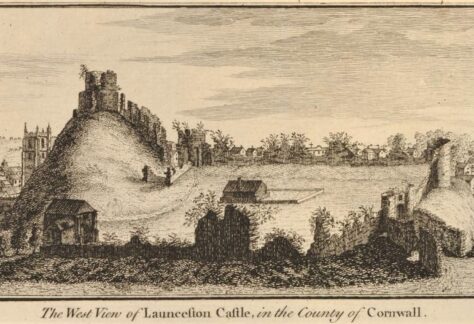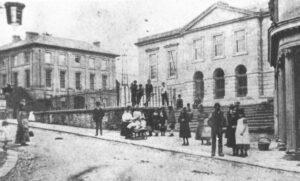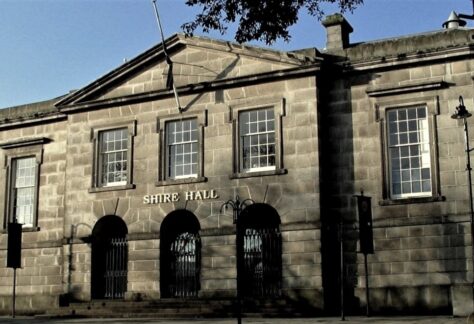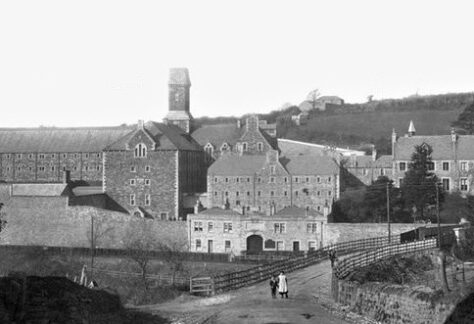Ertach Kernow - Justice, Punishment and Prisons in Cornwall
The news that the police are throwing up a ring of steel around Cornwall and southwest England to prevent county lines drug trafficking illustrates how different law and order has changed over time and how and where it’s been administered. Not just the crimes, where today there are far more opportunities relating to the types of crime such as fraud and theft, but also far less severe punishment. Until the 19th century the task of keeping the peace was the responsibility of Parish Constables and the Justices of the Peace. Cornwall Constabulary was founded in 1857 after it became law to have a county police force. That’s all another story, as we look at some of the places Cornish Justice was administered.
It was the Assize of Clarendon under Henry II that began the transformation of English law leading to trial by jury. Henry created a number of assize courts that met in various towns in a periodic fashion in order to deal with felonies, those more serious crimes rather than misdemeanours. In Cornwall the assize were held at Launceston, perhaps due to its castle belonging to the Earls of Cornwall and that travel around Cornwall would have been difficult for the court justices due to poor roads. In 1268 Richard Earl of Cornwall had acquired Restormel Castle together with the small town of Lostwithiel, following his death in 1272 his son Edmund as Earl of Cornwall transferred the assizes to Lostwithiel. These were later moved back to Launceston where they remained until 1838 when transferred to Bodmin.
Besides assize courts there were also the courts that dealt with lesser crimes. The courts of quarter sessions established in 1388 sat four times a year in main administrative towns as well as borough towns. These courts heard cases that were beyond those of justices, without juries, in petty session but not serious enough for the assizes. The assizes heard cases that would be subject to capital punishment or later life imprisonment. From May 1787 transportation to Australia became an alternative to the death penalty and 80% were guilty of theft, which carried that punishment in many cases. Transportation sentences were for seven years, fourteen years or life. Imprisonment also included a great deal of flogging and hard labour which took many different forms, some more useful than others. It wasn’t until the 19th century that some degree of prison rehabilitation started to take place. To that point it had always been about retribution for wrongdoing and to set an example to help prevent others carrying out similar crimes.
Cornwall’s earliest assizes were held in Launceston from 1201 within the castle, which also acted as a gaol and was later rebuilt by Richard Earl of Cornwall during the mid-13th century. Following establishment of the Duchy of Cornwall in 1337 repairs were carried out and it is recorded that it was increasingly being used for assizes and as a gaol. Edward III held a council meeting in the castle during 1353, illustrating it was fit for purpose and not in a ruinous state. Further building work took place during the 15th century to improve its use as a gaol. During the 16th century when the antiquarian John Leland visited Launceston he noted that the chapel and great hall were being used for the assizes and other court sessions. Although the castle had gradually fallen into ruin, following the civil war in the 17th century a small gaol had been constructed within the bailey, where they also held executions. As the assizes were held in Launceston the castle became the primary gaol for Cornwall and was renowned for its poor treatment of prisoners and facilities. The Justices of the Peace had written to Lord North, then Prime Minister ‘We beg leave to represent to your Lordship how cruel the delay has already been to the unhappy wretches confined in so deplorable a place; which has at times been so bad as that the Justices of the Peace have not thought themselves justified in committing thither such persons as have been brought to them.’ Launceston Gaol was closed in 1829 with Bodmin becoming Cornwall’s main prison. The assizes and other lesser court cases were by the 17th century being held in Launceston Guildhall; a timber building completed in 1647, located in the centre of the town. As judges continued to travel to the Assizes and Quarter Sessions the arrival of the railway to Bodmin in 1834 as well as the completion of the far better provisioned Bodmin Gaol in 1779 led to Bodmin becoming the new location for Cornwall’s assizes. The new Shire Hall was constructed and completed in 1838 with two principal courtrooms, remaining the principle court for Cornwall for 150 years.
It was a practical move in centralising justice in Bodmin, but also was a way of reducing costs by way of prisoner transfer as well as convenience for judges and lawyers. An Act of Parliament was passed in 1836 entitled ‘An Act for building new Courts of Assize at Bodmin for the County of Cornwall , and for providing Judges Lodgings , and other Purposes connected therewith’. The site was that of what was known as the Refectory, a large friary building, bought by Bodmin Borough in 1556 following the dissolution of the monasteries and Reformation. Since then, it had been used for multiple purposes including shops, school, market and an inn. Sir John Maclean wrote ‘It was 150 feet in length and 60 feet in height and was adorned with a magnificent east window of Second Pointed work.’ He also deplored its destruction ‘It is much more likely that it was the Friary church, of which no other trace remained within the memory of man. This building was ruthlessly destroyed to make way for the new assize courts, the walls being thrown down without even removing the tracery of the windows.’
The Judges lodgings mentioned in the act were built on the site of a building called Mayoralty House a quadrangle shaped building with a central courtyard. This was replaced in 1836 with the new accommodation building which always had a resident family as well as any visiting judges, clerks and staff.
Following an Act of Parliament passed in 1778, ‘An act for building an additional jail, and also a prison and house of correction within the county of Cornwall; and for other purposes therein mentioned’, Bodmin Gaol that became Cornwall’s central prison was completed in 1779. This was the first modern prison completed in Britain and based on plans by reformist John Howard. The state of Cornwall’s prisons was poor and full of prisoners who were there as debtors. Bodmin had its own debtors prison which still exists as a pub called The Hole in the Wall.
The new prison was the first to have individual sleeping cells, was light and airy, total segregation of male and female prisoners, running water, a chapel and an infirmary. Although prisons had been seen as a place of detention rather than punishment by the end of the 18th century employment was encouraged. However, the 1865 Prisons Act changed that ideal. It introduced treadmills and other unproductive work; a treadmill was installed in Bodmin Gaol. A mutiny led by James Sowden in 1827 saw a riot take place with the treadmill destroyed, but this was brutally suppressed. A more enlightened regime was introduced in 1898 encouraging productive constructive employment and ending hard labour. With the abolition of imprisonment for debt in 1869 part of the prison, through underutilisation, was passed to the Admiralty for use as a royal naval prison
There were huge numbers of crimes that were punishable by death and sentences were still harsh for minor offences such as theft of a hen, what we would relate to perhaps shoplifting an oven ready chicken. Hangings for relatively minor offences had been often replaced by transportation to Australia, even so Bodmin Gaol saw 50 hangings in its 150 years of use. It closed in 1927 and all the buildings within the Gaol sold in 1929. The following years have seen different parts of the gaol estate owned by many people for different usage, including as a nightclub by an old friend of mine George Morcom. Now as the latest owners tell us ‘The Bodmin Jail Hotel has been painstakingly renovated from a dilapidated former jail into a boutique, modern hotel, ..…. It is a unique place to stay.’ Visitors will with any luck set aside any thoughts on the horrors that took place there and hopefully enjoy a good night’s sleep.
Following The Court Act 1971 there was a wholesale modernisation in the system of dealing with criminal cases. It established the Crown Court along with the posts of circuit judges and recorders sweeping away all the local courts including the assizes and Quarter Sessions. The Senior Courts Act 1981 repealed some parts of the 1971 act, but the general structure remains with single Crown Courts. On completion of The Courts of Justice in Truro in 1988 the Crown Court relocated to Truro.









![[107] Voice - Ertach Kernow- 130722A The Rule of Law [S] Ertach Kernow - The Rule of Law - Administering Cornish Justice](https://www.cornwallheritage.com/wp-content/uploads/2022/07/107-Voice-Ertach-Kernow-130722A-The-Rule-of-Law-S-237x300.jpg)
![[107] Voice - Ertach Kernow- 130722B The Rule of Law [S] Ertach Kernow - The Rule of Law Administering Cornish Justice](https://www.cornwallheritage.com/wp-content/uploads/2022/07/107-Voice-Ertach-Kernow-130722B-The-Rule-of-Law-S-239x300.jpg)
![[107] Ertach Kernow Heritage Column - 13th July 2022 - Royal Cornwall Museum Bombshell Ertach Kernow Heritage Column - 13th July 2022 - Royal Cornwall Museum Bombshell](https://www.cornwallheritage.com/wp-content/uploads/2022/07/107-Ertach-Kernow-Heritage-Column-13th-July-2022-Royal-Cornweall-Museum-Bombshell-287x300.png)